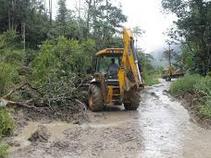 Sliding is the process and result of sliding or sliding : moving an item carefully across a surface , making something arrive by overcoming a difficulty, flowing in a certain direction, or delivering something surreptitiously.
Sliding is the process and result of sliding or sliding : moving an item carefully across a surface , making something arrive by overcoming a difficulty, flowing in a certain direction, or delivering something surreptitiously.
The concept is usually used with respect to the movement of earth that is generated by an unstable slope . This instability causes part of the terrain to slide over another area. A low intensity earthquake and heavy rain can also cause a landslide.
In October 1963 a tragic landslide occurred in Italy . The filling of the Vajont Dam reservoir caused the sliding of millions of cubic meters of rock and earth, which in turn caused the displacement of millions of cubic meters of water. The result was the formation of a tsunami that destroyed several towns and left nearly 2,000 dead.
The dam known as the Vajont Dam is located in the Friuli-Venezia Giulia region, more precisely in the province of Pordenone, and is no longer used today. Its construction took place two years before the incident, and its dimensions placed it among the tallest in the world.
It can be said that a landslide is a movement of stones, vegetation and earth that occurs due to the lack of firmness of the ground . This movement can be fast or slow, depending on the case.
In the most serious cases, a landslide can kill a large number of people, as happened with the Vajont Dam in 1963 . It can also cause significant material losses, destroying homes and flooding roads.
Even waste slides can occur when tons of waste accumulates in the mountains and is created in landfills. In April 2017 , more than twenty people died in Sri Lanka due to a landslide of this type.
In the field of physics , sliding is one of the many phenomena that is studied, to provide the greatest amount of data to help us analyze it and, if we wish, cause it. In this case we are not talking about land masses, although through this science we can also explain the aforementioned accidents, but rather the basic representation tells us about the sliding of a body on an inclined plane.
 The body in question, a perfectly polished sphere, moves with a uniformly accelerated rectilinear movement , meaning that its progress has a constant speed and occurs in a perfectly straight line. If we place it on a plane with a certain inclination, given the combination with other properties, it will slide towards the center of gravity; Although forces such as friction and other obstacles could slow the sphere or alter its speed, in the theoretical example there are no such problems.
The body in question, a perfectly polished sphere, moves with a uniformly accelerated rectilinear movement , meaning that its progress has a constant speed and occurs in a perfectly straight line. If we place it on a plane with a certain inclination, given the combination with other properties, it will slide towards the center of gravity; Although forces such as friction and other obstacles could slow the sphere or alter its speed, in the theoretical example there are no such problems.
The sliding occurs because all bodies are subjected to the attraction of the force of gravity constantly exerted by our planet; If we add to that the location on an inclined plane and low or no friction values, it is expected that they will begin to descend until the inclination of the ground is much lower or zero, or until an obstacle forces them to stop.
Regarding the value of the acceleration, in this case it is greater the more inclined the plane is. In free fall, where the angle between the Earth and the body's path is right (that is, 90°), the acceleration due to gravity is 9.8 meters per second squared. For surfaces with different inclination angles, the equation consists of multiplying said maximum gravity value by the sine of the angle.
